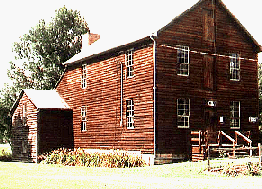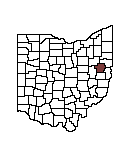The Algonquin / Tope Mill

After moving to Carroll County,
Ohio around 1800, George TOPE built the area's first saw mill (formerly
named Tope Mill) in 1815, and the area's first grist mill in 1818. The
relatively small buhrs were turned by an undershot wheel with power derived from a dam
and millrace. The McGuire Fork, a branch of the Conotton Creek, does not pass the mill now, but it is still
visible some distance from the mill site.
George operated the mill until his death in 1845, after
which it was operated by members of his family until 1865 when it was sold. In
1879, Dr. Jasper TOPE bought the mill and owned
it until 1890 with partial interests being held at various times by relatives. Dr.TOPE's
office was on a site within a few feet of the mill. If you visit the
mill, his office was on the site where a building now is used for the
sale of bread during the festival, which has been held the second weekend in October since 1971.
A new owner installed boilers and converted from water to
steam power. Previously, when meal or flour came from the buhrs,
it was put through a small hand-operated roller to remove the
coarser particles to produce a finer product. This involved much extra work,
and converting from water to steam power was a great improvement.
In 1917 a second set of boilers were installed in the mill.
At its peak, the mill produced 25 barrels in 24 hours, grinding, as it
does today, wheat, corn and buckwheat. It was shut
down in 1938 for the first time in 120 years. The village of Algonquin, now Petersburg (no
one seems to know why or when the name was changed), named for the Indian camp, was platted on 23 Sept. 1867, by Joseph TOPE
and Cornelius BRACKIN, but the plat evidently never was recorded. The village had a population of 200 and a post office called Algonquin.
It was established 19 Sept. 1851, with Hiram TOPE as the first postmaster.
The office was discontinued from 1864-66, but was re-established
and continued in operation until 5 Dec. 1907.
During World War II, the boiler was sold as scrap for the
war effort. When the Carroll County Historical Society acquired the
mill, it was necessary to purchase a new boiler. The Carroll
County Historical Society purchased the mill in 1969, and dedicated itself to
the preservation of, and restoration of the property as nearly as possible to the
original. The 3.88 acre mill complex is listed on the
National Registry of Historic Sites by the United States Department of Interior.
( This information was excerpted from Carroll Historical Society brochures. )



